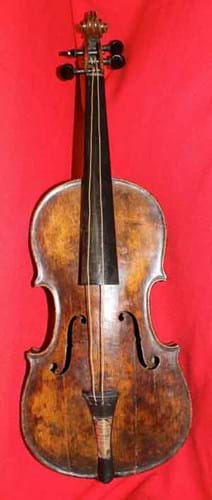And so it proved for a saleroom in a small, landlocked Wiltshire town, as three outside broadcast vans and ten camera crews descended on Henry Aldridge of Devizes on October 19.
The instrument in question was German, probably Berlin or Dresden school, c.1880, bearing a later label for Giovan Paolo Maggini Brescia. It was given to Dewsbury resident Hartley as a gift from his fiancée Maria Robinson on the event of their engagement.
Its wider significance lies in the fact that Hartley is credited with the decision to lead his eight-strong band into the historic hymn Nearer, My God, to Thee in an attempt to calm passengers as they boarded lifeboats. All eight men perished in the disaster, and Hartley's remains were recovered on April 25, 1912, by the crew of the ship CS MacKay-Bennett. The violin was sold alongside a leather luggage case initialled W. H. H. (Wallace Henry Hartley), in which Wallace placed the instrument before going into the freezing North Atlantic.
The bidding battle 101 years later included one Chinese and one Australian bidder along with sizeable US and British interest - and a starting bid on the books of just £50 which actually kicked off proceedings, according to Andrew Aldridge from the family firm...
Titanic and auction house records eventually tumbled after a final showdown between a British collector and a US collector, both on the phone, which the former won, paying a £900,000 hammer price (plus 15% buyer's premium).
Andrew said of the successful bidder: "He collects Titanic memorabilia but he also collects iconic items from history, so he is not specific to any one particular field. This was one of those choice pieces. It attracts the category of extremely wealthy individuals who want the very best - that's the half a per cent at the very top, who will only settle for iconic, once-in-a-lifetime opportunities. This was one of them."
Henry Aldridge set the previous Titanic item auction record in May 2011 when a very large, hand-drawn plan of the ship, used in the official inquiry after it sank, sold for £220,000. Given no precedent apart from that world record, the violin's estimate had been pitched at £200,000-300,000.
The saleroom's involvement with Titanic sales began in 1996 when they decided to sell a set of lunch menus brought in to them rather than passing it on to others who were specialising at the time. Those menus made £10,500, comfortably above the £8000 or so which was the auction world record for Titanic items at the time, and regular sales followed, building up a large following.
Andrew said: "What's unique about this market is although it's such a specialist, niche market, it's not over-reliant on one individual, where if something happens to that person, it can go over a precipice overnight, but with Titanic we have about 10,000 on the database. Of course, not all of them have the means to be bidding five to six figures but we have about 25-30 individuals who are quite comfortable with that amount and over. Because of that, whenever you get a choice piece that is a rare opportunity, it is going to make good money."
The provenance of the instrument and associated collection can be traced back to Maria Robinson and its discovery in Halifax, Nova Scotia, through to the present day.
The violin - consigned by a private individual from the north of England - was first discovered in 2006 when the saleroom received a phone call and went to investigate. With the instrument having something of a mythical status perhaps, and the market inevitably attracting fakes, it took a huge amount of research involving nine or ten individual experts and a wide range of verification techniques ranging from analysis by the Home Office Forensic Science Service and a CT scan of the interior of the instrument.
"The Titanic violin had always been an urban myth, so because of that it needed a phenomenal amount of work," said Andrew. "The best way to look at it is it was like a 50-piece jigsaw puzzle and each component piece was interesting but didn't actually prove anything... but get them all together and in the right order, and then you get the picture you are looking for."
The provenance eventually amounted to two packages that when put together came to about 2in thick.
With the centenary of the Titanic's sad end now past, how much more appetite is left among collectors? Well, Henry Aldridge are certainly confident those collectors remain hungry - their next Titanic and transport sale is in April next year.





